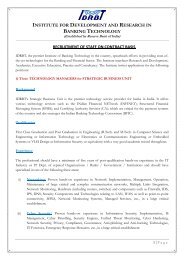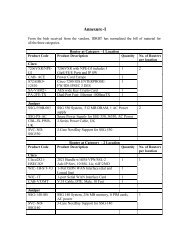New method for feature extraction based on fractal behavior - IDRBT
New method for feature extraction based on fractal behavior - IDRBT
New method for feature extraction based on fractal behavior - IDRBT
You also want an ePaper? Increase the reach of your titles
YUMPU automatically turns print PDFs into web optimized ePapers that Google loves.
Pattern Recogniti<strong>on</strong> 35 (2002) 1071–1081<br />
www.elsevier.com/locate/patcog<br />
<str<strong>on</strong>g>New</str<strong>on</strong>g> <str<strong>on</strong>g>method</str<strong>on</strong>g><str<strong>on</strong>g>for</str<strong>on</strong>g> <str<strong>on</strong>g>feature</str<strong>on</strong>g> <str<strong>on</strong>g>extracti<strong>on</strong></str<strong>on</strong>g> <str<strong>on</strong>g>based</str<strong>on</strong>g><strong>on</strong> <strong>fractal</strong> <strong>behavior</strong><br />
Yuan Y. Tang, Yu Tao ∗ , Ernest C.M. Lam<br />
Department of Computer Science, H<strong>on</strong>g K<strong>on</strong>g Baptist University, Waterloo Road, Kowlo<strong>on</strong> T<strong>on</strong>g, H<strong>on</strong>g K<strong>on</strong>g<br />
Received17 July 2000; accepted19 April 2001<br />
Abstract<br />
In this paper, a novel approach to <str<strong>on</strong>g>feature</str<strong>on</strong>g> <str<strong>on</strong>g>extracti<strong>on</strong></str<strong>on</strong>g> <str<strong>on</strong>g>based</str<strong>on</strong>g><strong>on</strong> <strong>fractal</strong> theory is presentedas a powerful technique in<br />
pattern recogniti<strong>on</strong>. This paper presents a new <strong>fractal</strong> <str<strong>on</strong>g>feature</str<strong>on</strong>g> that can be appliedto extract the <str<strong>on</strong>g>feature</str<strong>on</strong>g> of two-dimensi<strong>on</strong>al<br />
objects. It is c<strong>on</strong>structedby a hybrid<str<strong>on</strong>g>feature</str<strong>on</strong>g> <str<strong>on</strong>g>extracti<strong>on</strong></str<strong>on</strong>g> combining wavelet analysis, central projecti<strong>on</strong> trans<str<strong>on</strong>g>for</str<strong>on</strong>g>mati<strong>on</strong><br />
and<strong>fractal</strong> theory. <str<strong>on</strong>g>New</str<strong>on</strong>g> <strong>fractal</strong> <str<strong>on</strong>g>feature</str<strong>on</strong>g> and<strong>fractal</strong> signatures are reported. A multiresoluti<strong>on</strong> family of the wavelets is<br />
also usedto compute in<str<strong>on</strong>g>for</str<strong>on</strong>g>mati<strong>on</strong> c<strong>on</strong>serving micro-<str<strong>on</strong>g>feature</str<strong>on</strong>g>s. We employeda central projecti<strong>on</strong> <str<strong>on</strong>g>method</str<strong>on</strong>g>to reduce the<br />
dimensi<strong>on</strong>ality of the original input pattern. A wavelet trans<str<strong>on</strong>g>for</str<strong>on</strong>g>mati<strong>on</strong> technique to trans<str<strong>on</strong>g>for</str<strong>on</strong>g>m the derived pattern into<br />
a set of sub-patterns. Its <strong>fractal</strong> dimensi<strong>on</strong> can readily be computed, and to use the <strong>fractal</strong> dimensi<strong>on</strong> as the <str<strong>on</strong>g>feature</str<strong>on</strong>g><br />
vectors. Moreover, a modied <strong>fractal</strong> signature is also used to distinguish the distinct handwritten signatures. We expect<br />
that the proposed<strong>fractal</strong> <str<strong>on</strong>g>method</str<strong>on</strong>g>can also be used<str<strong>on</strong>g>for</str<strong>on</strong>g> improving the <str<strong>on</strong>g>extracti<strong>on</strong></str<strong>on</strong>g> andclassicati<strong>on</strong> of <str<strong>on</strong>g>feature</str<strong>on</strong>g>s in pattern<br />
recogniti<strong>on</strong>. ? 2002 Pattern Recogniti<strong>on</strong> Society. Published by Elsevier Science Ltd. All rights reserved.<br />
Keywords: Feature <str<strong>on</strong>g>extracti<strong>on</strong></str<strong>on</strong>g>; Fractal geometry; Box dimensi<strong>on</strong>; Wavelet trans<str<strong>on</strong>g>for</str<strong>on</strong>g>mati<strong>on</strong>; Handwritten signature vericati<strong>on</strong>;<br />
Central projecti<strong>on</strong> trans<str<strong>on</strong>g>for</str<strong>on</strong>g>mati<strong>on</strong><br />
1. Introducti<strong>on</strong><br />
Fractal <strong>behavior</strong> andstructure can be intuitively appreciatedin<br />
a variety of ways. Fractal is mathematical<br />
sets with a high degree of geometrical complexity, which<br />
can model many classes of time-series data as well as<br />
images. The <strong>fractal</strong> dimensi<strong>on</strong> is an important characteristic<br />
of <strong>fractal</strong>s; it c<strong>on</strong>tains in<str<strong>on</strong>g>for</str<strong>on</strong>g>mati<strong>on</strong> about their geometrical<br />
structure. As the interest in <strong>fractal</strong> geometry<br />
rises, the applicati<strong>on</strong>s are getting more andmore numerous<br />
in many domains. This paper aims at showing<br />
that these c<strong>on</strong>cepts can also be appliedto <str<strong>on</strong>g>feature</str<strong>on</strong>g> <str<strong>on</strong>g>extracti<strong>on</strong></str<strong>on</strong>g><br />
in pattern recogniti<strong>on</strong>. The motivati<strong>on</strong> behindusing<br />
∗ Corresp<strong>on</strong>ding author. Tel.: +1-852-2339-5973;<br />
fax: +1-852-2339-7892.<br />
E-mail addresses: yytang@comp.hkbu.edu.hk (Y.Y. Tang),<br />
taoyu@comp.hkbu.edu.hk (Y. Tao), ecmlam@comp.hkbu.edu.<br />
hk (E.C.M. Lam).<br />
<strong>fractal</strong> trans<str<strong>on</strong>g>for</str<strong>on</strong>g>mati<strong>on</strong>s is to develop a novel <str<strong>on</strong>g>feature</str<strong>on</strong>g><br />
<str<strong>on</strong>g>extracti<strong>on</strong></str<strong>on</strong>g> technique, which can not <strong>on</strong>ly be usedto<br />
recognize dierent two-dimensi<strong>on</strong>al objects, but also utilized<br />
to identify dierent handwritten signatures. In this<br />
paper, we are investigating the utility of several emerging<br />
techniques to extract additi<strong>on</strong>al in<str<strong>on</strong>g>for</str<strong>on</strong>g>mati<strong>on</strong>. These<br />
<str<strong>on</strong>g>method</str<strong>on</strong>g>s include utilizing <strong>fractal</strong> <str<strong>on</strong>g>feature</str<strong>on</strong>g>s to enhance<br />
pattern discriminati<strong>on</strong>, central projecti<strong>on</strong> trans<str<strong>on</strong>g>for</str<strong>on</strong>g>mati<strong>on</strong><br />
to describe the shape of a regi<strong>on</strong>, and wavelet <str<strong>on</strong>g>feature</str<strong>on</strong>g>s to<br />
aidin segmentati<strong>on</strong> andboundary identicati<strong>on</strong>. Use of<br />
these new techniques has yielded very promising results.<br />
Fractal is a new discipline in the eld of mathematics,<br />
which has been developedin last 20 years andis<br />
<strong>on</strong>e of the most important scientic discoveries in this<br />
century. Fractals combinedwith the other n<strong>on</strong>linear science<br />
theories bring us the dawn of scientic revoluti<strong>on</strong>.<br />
It proposes a powerful tool <str<strong>on</strong>g>for</str<strong>on</strong>g> human being to explore<br />
the complexity. There<str<strong>on</strong>g>for</str<strong>on</strong>g>e, there are more andmore<br />
researches focusing <strong>on</strong> the theoretic andapplied<br />
0031-3203/02/$22.00 ? 2002 Pattern Recogniti<strong>on</strong> Society. Published by Elsevier Science Ltd. All rights reserved.<br />
PII: S0031-3203(01)00095-4
1072 Y.Y. Tang et al. / Pattern Recogniti<strong>on</strong> 35 (2002) 1071–1081<br />
investigati<strong>on</strong>s of this new subject. Since Mandelbrot [1]<br />
proposedthis technique, the subject of <strong>fractal</strong> dimensi<strong>on</strong><br />
has drawn a great deal of attenti<strong>on</strong> from mathematicians,<br />
physicists, chemists, biologists, geologists, andelectrical<br />
andcomputer engineers in various disciplines. Specically,<br />
in the area of pattern recogniti<strong>on</strong> andimage processing,<br />
the <strong>fractal</strong> dimensi<strong>on</strong> has been used <str<strong>on</strong>g>for</str<strong>on</strong>g> image<br />
compressi<strong>on</strong>, texture segmentati<strong>on</strong> and<str<strong>on</strong>g>feature</str<strong>on</strong>g> <str<strong>on</strong>g>extracti<strong>on</strong></str<strong>on</strong>g><br />
[2–5], etc. The process of pattern recogniti<strong>on</strong> requires<br />
the <str<strong>on</strong>g>extracti<strong>on</strong></str<strong>on</strong>g> of <str<strong>on</strong>g>feature</str<strong>on</strong>g>s from regi<strong>on</strong>s of the image, and<br />
the processing of these <str<strong>on</strong>g>feature</str<strong>on</strong>g>s with a pattern classicati<strong>on</strong><br />
algorithm. Many applicati<strong>on</strong>s of <strong>fractal</strong> c<strong>on</strong>cepts<br />
rely <strong>on</strong> the ability to estimate the <strong>fractal</strong> dimensi<strong>on</strong> of<br />
objects. One of the basic characteristics of a <strong>fractal</strong> is its<br />
dimensi<strong>on</strong>. A <strong>fractal</strong> object can be characterized by its<br />
dimensi<strong>on</strong> which is a way of interpretati<strong>on</strong>, determines<br />
how much “space” it occupies between arbitrary m and<br />
m+1 dimensi<strong>on</strong>al manifolds. This <str<strong>on</strong>g>feature</str<strong>on</strong>g> has been used<br />
in texture classicati<strong>on</strong>, segmentati<strong>on</strong>, shape analysis<br />
andother problems [6–8]. All these approaches face and<br />
attempt to solve two basic problems: (1) accuracy of the<br />
estimate, (2) amount of in<str<strong>on</strong>g>for</str<strong>on</strong>g>mati<strong>on</strong> needed to obtain the<br />
estimate. In this paper, we utilize a <str<strong>on</strong>g>method</str<strong>on</strong>g>called“ box<br />
counting dimensi<strong>on</strong>” to estimate the <strong>fractal</strong> dimensi<strong>on</strong><br />
of an image. All of these <str<strong>on</strong>g>feature</str<strong>on</strong>g>s rely <strong>on</strong> computing the<br />
mass probability density functi<strong>on</strong> <str<strong>on</strong>g>based</str<strong>on</strong>g> <strong>on</strong> the central<br />
projecti<strong>on</strong> trans<str<strong>on</strong>g>for</str<strong>on</strong>g>mati<strong>on</strong> andwavelet decompositi<strong>on</strong><br />
<str<strong>on</strong>g>for</str<strong>on</strong>g> the <strong>fractal</strong> set. We analyze the box counting <str<strong>on</strong>g>method</str<strong>on</strong>g>ology<br />
from the standpoint of computing <strong>fractal</strong> <str<strong>on</strong>g>feature</str<strong>on</strong>g>s.<br />
We focus <strong>on</strong> <strong>fractal</strong> dimensi<strong>on</strong> <str<strong>on</strong>g>for</str<strong>on</strong>g> computing the <strong>fractal</strong><br />
signature. This c<strong>on</strong>cept can be useful in the measurement<br />
andclassicati<strong>on</strong> of pattern’s <str<strong>on</strong>g>feature</str<strong>on</strong>g>s.<br />
2. Basic theory and algorithm<br />
Fractal theory is <str<strong>on</strong>g>based</str<strong>on</strong>g><strong>on</strong> geometry anddimensi<strong>on</strong><br />
theories. Fractals are mathematical sets with a high degree<br />
of geometrical complexity, which can model many<br />
classes of time series data as well as images. The <strong>fractal</strong><br />
dimensi<strong>on</strong> is an important characteristic of <strong>fractal</strong>s because<br />
it c<strong>on</strong>tains in<str<strong>on</strong>g>for</str<strong>on</strong>g>mati<strong>on</strong> about their geometric structure.<br />
It has become an eective tool to study complex<br />
sets. There are many deniti<strong>on</strong>s <str<strong>on</strong>g>for</str<strong>on</strong>g> the <strong>fractal</strong> dimensi<strong>on</strong>s<br />
of a <strong>fractal</strong> set [9,10]. The simplest andmost appealing<br />
way of assigning a dimensi<strong>on</strong> to a set that can yield a<br />
<strong>fractal</strong> dimensi<strong>on</strong> to certain kinds of sets is the so-called<br />
box dimensi<strong>on</strong>. In the secti<strong>on</strong>, the important c<strong>on</strong>cept and<br />
algorithm about box dimensi<strong>on</strong> and modied algorithm<br />
of <strong>fractal</strong> dimensi<strong>on</strong> will be introduced.<br />
2.1. Fractal dimensi<strong>on</strong><br />
Fundamental to most deniti<strong>on</strong>s of dimensi<strong>on</strong> is the<br />
idea of measurement at scale . For each , a set can be<br />
measuredin a way that ignores irregularities of size less<br />
than , andwe see how these measurements behave as<br />
→ 0.<br />
Suppose F is a plane curve, the measurement M (F)<br />
denotes the number of sets (with length ) which divide<br />
the set F. A dimensi<strong>on</strong> of F is determined by the power<br />
law obeyedby M (F) as → 0. If<br />
M (F) ∼ K −s ; (1)<br />
<str<strong>on</strong>g>for</str<strong>on</strong>g> c<strong>on</strong>stants K and s, we might say that F has dimensi<strong>on</strong><br />
s, and K can be c<strong>on</strong>sidered as “s-dimensi<strong>on</strong>al length”<br />
of F.<br />
Taking the logarithm of both sides in Eq. (1) yields<br />
the <str<strong>on</strong>g>for</str<strong>on</strong>g>mula:<br />
log 2 M (F) ≃ log 2 K − s log 2 ;<br />
in the sense that the dierence of the two sides tends<br />
to 0 with , this suggests that the box dimensi<strong>on</strong> of F,<br />
denoted by dim(F), shouldsatisfy<br />
log<br />
dim(F) = lim 2 M (F)<br />
→0 −log 2 : (2)<br />
If the limit exists, dim(F) is calledthe <strong>fractal</strong> dimensi<strong>on</strong><br />
of set F.<br />
2.2. Box counting dimensi<strong>on</strong> (BCD)<br />
Box computing dimensi<strong>on</strong> or box dimensi<strong>on</strong> is <strong>on</strong>e of<br />
the most widely used dimensi<strong>on</strong>s. Its popularity is largely<br />
due to its relative ease of mathematical calculati<strong>on</strong> and<br />
empirical estimati<strong>on</strong>.<br />
Let F be a n<strong>on</strong>-empty andboundedsubset of<br />
R n ;= {! i : i =1; 2; 3;:::} be covers of the set F. N (F)<br />
denotes the number of covers, such that<br />
N (F)=|: d i 6 |;<br />
where d i stands <str<strong>on</strong>g>for</str<strong>on</strong>g> the diameter of the ith cover. This<br />
equati<strong>on</strong> means that N (F) is the smallest number of<br />
subsets which cover the set F, andtheir diameters d i ’s<br />
are not greater than .<br />
The upper andlower bounds of the box computing<br />
dimensi<strong>on</strong> of F can be dened by the following <str<strong>on</strong>g>for</str<strong>on</strong>g>mulas:<br />
log<br />
dim B F = lim 2 N (F)<br />
→0 −log 2 ;<br />
log<br />
dim B F = lim 2 N (F)<br />
→0 −log 2 ; (3)<br />
where the overline stands <str<strong>on</strong>g>for</str<strong>on</strong>g> the upper bound of dimensi<strong>on</strong><br />
while the underline <str<strong>on</strong>g>for</str<strong>on</strong>g> lower bound.<br />
If both the upper bounddim B F andthe lower bound<br />
dim B F are equal, i.e.<br />
log<br />
lim 2 N (F)<br />
→0 −log 2 <br />
= lim log 2 N (F)<br />
→0 −log 2 ;
Y.Y. Tang et al. / Pattern Recogniti<strong>on</strong> 35 (2002) 1071–1081 1073<br />
the comm<strong>on</strong> value is called box computing dimensi<strong>on</strong> or<br />
box dimensi<strong>on</strong> of F, namely<br />
log<br />
dim B F = lim 2 N (F)<br />
→0 −log 2 : (4)<br />
Further discussi<strong>on</strong>s <strong>on</strong> <strong>fractal</strong> theory can be found in<br />
Refs. [11,12,10].<br />
The modied box computing dimensi<strong>on</strong> <str<strong>on</strong>g>method</str<strong>on</strong>g> gives<br />
a very goodestimate of <strong>fractal</strong> dimensi<strong>on</strong>. It can be easily<br />
shown that computati<strong>on</strong> complexity of other approaches,<br />
including the original box counting dimensi<strong>on</strong>, is much<br />
higher than that of this approach. Thus it has the advantages<br />
of simplicity in computati<strong>on</strong> andimprovement in<br />
eciency.<br />
2.3. Minkowski dimensi<strong>on</strong> and modied <strong>fractal</strong><br />
signature<br />
There is an important equivalent deniti<strong>on</strong> of box<br />
counting dimensi<strong>on</strong> of a rather dierent <str<strong>on</strong>g>for</str<strong>on</strong>g>m that is the<br />
-parallel body F of F.<br />
F = {x ∈ R n : |x − y| 6 ; <str<strong>on</strong>g>for</str<strong>on</strong>g> y ∈ F}: (5)<br />
If F is a subset of R n and, <str<strong>on</strong>g>for</str<strong>on</strong>g> some d, if the limit of<br />
[Vol n (F )]= n−d tends to be positive and nite as → 0,<br />
then it makes sense to regard F as d-dimensi<strong>on</strong>. The<br />
limiting value is calledthe Minkowski dimensi<strong>on</strong> of F,<br />
nameddim M F. Vol n (F ) is Lebesgue measure of F.<br />
Even if this limit does not exist, we may be able to extract<br />
the critical exp<strong>on</strong>ent of andthis turns out to be<br />
relatedto the box dimensi<strong>on</strong>. The initial andkey step <str<strong>on</strong>g>for</str<strong>on</strong>g><br />
Minkowski dimensi<strong>on</strong> is to evaluate the Vol(F ) under<br />
dierent .<br />
The relati<strong>on</strong>ship between the box counting dimensi<strong>on</strong><br />
and Minkowski dimensi<strong>on</strong> can be provided by the following<br />
equati<strong>on</strong>:<br />
log<br />
dim B F = n − lim 2 Vol n (F )<br />
;<br />
→0 −log 2 <br />
log<br />
dim B F = n − lim 2 Vol n (F )<br />
; (6)<br />
→0 −log 2 <br />
where F stands <str<strong>on</strong>g>for</str<strong>on</strong>g> -parallel body of F, and<br />
Vol n (F ) denotes n-dimensi<strong>on</strong> area or volume of F .<br />
For a n<strong>on</strong>empty andboundedset F in R n , we have<br />
dim M F =dim B F.<br />
Let F = {X i;j };i=0; 1;:::;K; j=0; 1;:::;L be the<br />
image of a pattern with multi-gray level, and X i;j be<br />
the gray level of the (i; j)th pixel. In a certain measure<br />
range, the gray level surface of F can be viewedas a<br />
<strong>fractal</strong>. The surface area can be usedto approximate its<br />
<strong>fractal</strong> dimensi<strong>on</strong>.<br />
In particular, the gray level functi<strong>on</strong> F is a n<strong>on</strong>empty<br />
andboundedset in R 3 <str<strong>on</strong>g>for</str<strong>on</strong>g> either text areas, graphics<br />
areas or backgroundareas in the pattern. We use a<br />
Fig. 1. Surface andits blankets.<br />
technique that is referredto as Blanket Technique [13]<br />
to thicken the functi<strong>on</strong> F. It leads to a set F , which is<br />
still a n<strong>on</strong>empty andboundedset in R 3 . According to the<br />
deniti<strong>on</strong> of Minkowski Dimensi<strong>on</strong> andRef. [5], we can<br />
c<strong>on</strong>clude that if<br />
Vol 3 (F<br />
lim )<br />
= ¿0;<br />
→0 3−D<br />
then<br />
D =dim M F =dim B F;<br />
where denotes a c<strong>on</strong>stant, Vol 3 (F ) stands <str<strong>on</strong>g>for</str<strong>on</strong>g> the volume<br />
of the blanket F .<br />
The idea of the blanket technique is <str<strong>on</strong>g>based</str<strong>on</strong>g> <strong>on</strong> the<br />
equivalent deniti<strong>on</strong> of the box computing dimensi<strong>on</strong><br />
shown in Eq. (5), i.e. the -parallel body. In the blanket<br />
technique, all points of the three-dimensi<strong>on</strong>al space at<br />
distance from the gray level surface are c<strong>on</strong>sidered.<br />
These points c<strong>on</strong>struct a “blanket” of thickness 2 covering<br />
this surface. A graphical illustrati<strong>on</strong> is shown in<br />
Fig. 1. The image is representedby a gray-level functi<strong>on</strong><br />
g(i; j). The covering blanket is dened by its upper<br />
surface u (i; j) andits lower surface b (i; j).<br />
• Initially, = 0 andgiven the gray-level functi<strong>on</strong><br />
equals the upper andlower surfaces, namely:<br />
g(i; j)=u 0 (i; j)=b 0 (i; j):<br />
• For =1; 2;:::, the blanket surfaces are dened as<br />
follows:<br />
u (i; j)<br />
{<br />
= max u −1 (i; j)+1;<br />
b (i; j)<br />
{<br />
= min b −1 (i; j) − 1;<br />
}<br />
max u −1 (m; n) ;<br />
|(m;n)−(i;j)|61<br />
(7)<br />
}<br />
min<br />
|(m;n)−(i;j)|61<br />
b −1 (m; n) :<br />
(8)
1074 Y.Y. Tang et al. / Pattern Recogniti<strong>on</strong> 35 (2002) 1071–1081<br />
The image pixels (m; n) with distance less than<br />
<strong>on</strong>e from (i; j) are taken to be the four immediate<br />
neighbors of (i; j). Similar expressi<strong>on</strong>s exist<br />
when the eight-neighborhood is desired. A point<br />
f(x; y) will be included in the blanket <str<strong>on</strong>g>for</str<strong>on</strong>g> when<br />
b (x; y) ¡f(x; y) ¡u (x; y). The blanket deniti<strong>on</strong><br />
uses the fact that the blanket of the surface <str<strong>on</strong>g>for</str<strong>on</strong>g><br />
radius includes all the points of the blanket <str<strong>on</strong>g>for</str<strong>on</strong>g> radius<br />
−1, together with all the points within radius<br />
1 from the surfaces of that blanket. Eq. (7) ensures<br />
that the new upper surface u is higher by at least<br />
1 from u −1 , andalso at a distance at least 1 from<br />
u −1 in the horiz<strong>on</strong>tal andvertical directi<strong>on</strong>s.<br />
The volume Vol of the blanket is computedfrom<br />
u and b :<br />
Vol = ∑ (u (i; j) − b (i; j)): (9)<br />
i;j<br />
As the volume Vol of the blanket is measuredwith<br />
radius , the area of a <strong>fractal</strong> surface can be deduced<br />
as<br />
A = Vol <br />
2<br />
or<br />
A = Vol − Vol −1<br />
: (10)<br />
2<br />
• Let A() be the area of the surface of the blanket.<br />
Based<strong>on</strong> the Minkowski dimensi<strong>on</strong>, we have<br />
A() ≈ 2−D ; if is suciently small; (11)<br />
where denotes a c<strong>on</strong>stant and D stands <str<strong>on</strong>g>for</str<strong>on</strong>g> the <strong>fractal</strong><br />
dimensi<strong>on</strong> of the image.<br />
Since the dimensi<strong>on</strong> can be regarded as a slope <strong>on</strong><br />
a log–log scale, <strong>on</strong>ly two points are needed to get<br />
the dimensi<strong>on</strong>. We use two values of to compute<br />
the <strong>fractal</strong> dimensi<strong>on</strong>, namely, we take = 1 and 2 ,<br />
then A 1 ≈ 2−D<br />
1<br />
and A 2 ≈ 2−D<br />
2<br />
. Thus, we have<br />
A 1 =A 2 ≈ 2−D<br />
1<br />
= 2−D<br />
2<br />
.<br />
Taking the logarithm of both sides yields<br />
2 − D ≈ log 2 A 1<br />
− log 2 A 2<br />
log 2 1 − log 2 2<br />
;<br />
D ≈ 2 − log 2 A 1<br />
− log 2 A 2<br />
: (12)<br />
log 2 1 − log 2 2<br />
It is usedto approximate the <strong>fractal</strong> dimensi<strong>on</strong> of the<br />
signature images, i.e.,<br />
D ≈ 2 − log 2 A() if is suciently small: (13)<br />
log 2 <br />
We call D as modied <strong>fractal</strong> signature of set F. It<br />
will be used to distinguish the dierent handwritten<br />
signatures.<br />
Several points are worth noting:<br />
1. Why do the dierent document images have dierent<br />
<strong>fractal</strong> dimensi<strong>on</strong>s? The essential distincti<strong>on</strong> of<br />
handwritten signature images is their values of A().<br />
2. The value of A() depends <strong>on</strong> the volume Vol 3 (F )<br />
of thickenedblanket F <strong>on</strong>ly.<br />
3. In summary, they can be representedas<br />
D ⇔ A() ⇔ Vol 3 (F ):<br />
C<strong>on</strong>sequently, in this paper, the volume Vol 3 (F )ofthe<br />
thickenedblanket F is applied to identify dierent handwritten<br />
signature, insteadof using the <strong>fractal</strong> dimensi<strong>on</strong>.<br />
We call such technique of approximating the <strong>fractal</strong> dimensi<strong>on</strong><br />
“Modied Fractal Signature”.<br />
3. Applicati<strong>on</strong>s<br />
From the specic point of view of shape characterizati<strong>on</strong><br />
of patterns the main aim of the <strong>fractal</strong> approach is to<br />
nd a “measure” to distinguish between curves with different,<br />
often very complicated, c<strong>on</strong>tours. The main idea<br />
is to describe the complexity of the curve through a new<br />
parameter, the <strong>fractal</strong> dimensi<strong>on</strong>, so as to ll in the gap<br />
between <strong>on</strong>e- andtwo-dimensi<strong>on</strong>al objects (<str<strong>on</strong>g>for</str<strong>on</strong>g> objects<br />
<strong>on</strong> a plane). Two applicati<strong>on</strong>s of the <strong>fractal</strong> theory are<br />
presentedin this secti<strong>on</strong>, namely: (1) the <strong>fractal</strong> technique<br />
is usedto extract the <str<strong>on</strong>g>feature</str<strong>on</strong>g>s <str<strong>on</strong>g>for</str<strong>on</strong>g> two-dimensi<strong>on</strong>al<br />
objects; (2) the <strong>fractal</strong> signature is employedto identify<br />
dierent handwritten signatures.<br />
3.1. Applicati<strong>on</strong> of <strong>fractal</strong> technique <str<strong>on</strong>g>for</str<strong>on</strong>g> <str<strong>on</strong>g>feature</str<strong>on</strong>g><br />
<str<strong>on</strong>g>extracti<strong>on</strong></str<strong>on</strong>g><br />
Feature <str<strong>on</strong>g>extracti<strong>on</strong></str<strong>on</strong>g> is a crucial step in pattern recogniti<strong>on</strong>.<br />
It is resp<strong>on</strong>sible <str<strong>on</strong>g>for</str<strong>on</strong>g> measuring the <str<strong>on</strong>g>feature</str<strong>on</strong>g>s of the<br />
objects in an image. Pattern recogniti<strong>on</strong> requires the <str<strong>on</strong>g>extracti<strong>on</strong></str<strong>on</strong>g><br />
of <str<strong>on</strong>g>feature</str<strong>on</strong>g>s from the regi<strong>on</strong>s of an image, andthe<br />
processing of these <str<strong>on</strong>g>feature</str<strong>on</strong>g>s with a pattern classicati<strong>on</strong><br />
technique. We employeda central projecti<strong>on</strong> <str<strong>on</strong>g>method</str<strong>on</strong>g><br />
to reduce the problem of two-dimensi<strong>on</strong>al patterns into<br />
that of <strong>on</strong>e-dimensi<strong>on</strong>al <strong>on</strong>es, and thereafter, utilize<br />
the well-established<strong>on</strong>e-dimensi<strong>on</strong>al wavelet trans<str<strong>on</strong>g>for</str<strong>on</strong>g>m<br />
coupledwith <strong>fractal</strong> theory to extract the <strong>on</strong>e-dimensi<strong>on</strong>al<br />
pattern’s <str<strong>on</strong>g>feature</str<strong>on</strong>g> vectors <str<strong>on</strong>g>for</str<strong>on</strong>g> the purpose of pattern<br />
recogniti<strong>on</strong>. The key steps of the experimental procedure<br />
c<strong>on</strong>sist of the following:<br />
Step 1: Central projecti<strong>on</strong> of two-dimensi<strong>on</strong>al<br />
patterns: We denote each of the two-dimensi<strong>on</strong>al patterns<br />
in questi<strong>on</strong> by p(x; y). Thus, the central projecti<strong>on</strong><br />
of p(x; y) can be expressedas follows:<br />
f(x k )=<br />
M∑<br />
p(x k cos i ;x k sin i ): (14)<br />
i=0<br />
Step 2: Wavelet trans<str<strong>on</strong>g>for</str<strong>on</strong>g>mati<strong>on</strong> of the <strong>on</strong>e-dimensi<strong>on</strong>al<br />
patterns: Let f(x k )=c j;k , where k =0; 1;:::;2N −1 and<br />
V 0 = {c j;0 ;c j;1 ;:::;c j;2N−1 }:
Y.Y. Tang et al. / Pattern Recogniti<strong>on</strong> 35 (2002) 1071–1081 1075<br />
Fig. 2. Diagram of <str<strong>on</strong>g>feature</str<strong>on</strong>g> <str<strong>on</strong>g>extracti<strong>on</strong></str<strong>on</strong>g> by wavelet sub-patterns and divider dimensi<strong>on</strong>s <str<strong>on</strong>g>for</str<strong>on</strong>g> the Chinese character “Heart”.<br />
Thus, the expressi<strong>on</strong>s <str<strong>on</strong>g>for</str<strong>on</strong>g> the wavelet trans<str<strong>on</strong>g>for</str<strong>on</strong>g>mati<strong>on</strong> of<br />
V 0 can be written as follows:<br />
5∑<br />
5∑<br />
c j+1;m = h k c j;k+2m ; d j+1;m = g k c j;k+2m (15)<br />
k=0<br />
k=0<br />
where m =0; 1;:::;N − 1.<br />
Hence, the wavelet trans<str<strong>on</strong>g>for</str<strong>on</strong>g>mati<strong>on</strong> sub-patterns of V 0<br />
obtainedusing Eq. (16) will become<br />
V 1 = {c j+1;0 ;c j+1;1 ;:::;c j+1;N−1 };<br />
W 1 = {d j+1;0 ;d j+1;1 ;:::;d j+1;N−1 }: (16)<br />
Step 3. Computati<strong>on</strong> of divider dimensi<strong>on</strong>s <str<strong>on</strong>g>for</str<strong>on</strong>g><br />
wavelet sub-patterns: Since the divider dimensi<strong>on</strong>s of<br />
n<strong>on</strong>-self-intersecting curves are asymptotic values, we<br />
can derive their approximati<strong>on</strong>s <str<strong>on</strong>g>based</str<strong>on</strong>g> <strong>on</strong> the following<br />
expressi<strong>on</strong>:<br />
log M (C)<br />
−log ;<br />
when is set to be small enough. M (C) is the compass<br />
dimensi<strong>on</strong> computed with a ruler of size al<strong>on</strong>g the<br />
curve C.<br />
In our experiments, we per<str<strong>on</strong>g>for</str<strong>on</strong>g>medthree c<strong>on</strong>secutive<br />
wavelet trans<str<strong>on</strong>g>for</str<strong>on</strong>g>mati<strong>on</strong>s <str<strong>on</strong>g>for</str<strong>on</strong>g> each <strong>on</strong>e-dimensi<strong>on</strong>al<br />
pattern. Hence, the <strong>on</strong>e-dimensi<strong>on</strong>al pattern, such as<br />
the central projecti<strong>on</strong> of the Chinese character “Heart”<br />
(Fig. 2), will yieldthree n<strong>on</strong>-self-intersecting curves;<br />
namely: V 0 ;V 1 ;W 1 . By comparing these two frequency<br />
spectra, we can ndthat V 0 c<strong>on</strong>tains all frequency comp<strong>on</strong>ents<br />
of f(x), while V 1 c<strong>on</strong>tains <strong>on</strong>ly <strong>on</strong>e half of the<br />
frequency comp<strong>on</strong>ents of f(x). The reas<strong>on</strong> is that V 0<br />
is divided into two parts: V 0 = V 1 ⊕ W 1 . As <str<strong>on</strong>g>for</str<strong>on</strong>g> the rst<br />
part, V 1 , <strong>on</strong>ly the low-frequency comp<strong>on</strong>ents of V 0 are<br />
kept, andthe high-frequency comp<strong>on</strong>ents are lost. In<br />
additi<strong>on</strong>, <strong>on</strong>ly the high-frequency comp<strong>on</strong>ents of V 0 are<br />
kept, andthe low-frequency comp<strong>on</strong>ents are lost in W 1 .<br />
For each of the three curves, we further computedits<br />
divider dimensi<strong>on</strong>, and there<str<strong>on</strong>g>for</str<strong>on</strong>g>e, related each pattern<br />
with a <str<strong>on</strong>g>feature</str<strong>on</strong>g> vector. These <str<strong>on</strong>g>feature</str<strong>on</strong>g> vectors are presented<br />
as follows:<br />
D vo =1:03911917; D V1 =1:03940148;<br />
D W1 =1:60938780:<br />
These <str<strong>on</strong>g>feature</str<strong>on</strong>g> vectors are selectedto be usedas the<br />
<strong>fractal</strong> <str<strong>on</strong>g>feature</str<strong>on</strong>g> <str<strong>on</strong>g>for</str<strong>on</strong>g> extracting the <str<strong>on</strong>g>feature</str<strong>on</strong>g>s of object. More<br />
details about the central projecti<strong>on</strong> trans<str<strong>on</strong>g>for</str<strong>on</strong>g>mati<strong>on</strong> and<br />
the orth<strong>on</strong>ormal wavelet decompositi<strong>on</strong> can be found in<br />
Ref. [14].<br />
In our experiments, we have testedour new approach<br />
<str<strong>on</strong>g>for</str<strong>on</strong>g> two types of images: 52 upper andlower case printed<br />
alphabets and3000 Chinese characters. We classify<br />
these <str<strong>on</strong>g>feature</str<strong>on</strong>g>s andper<str<strong>on</strong>g>for</str<strong>on</strong>g>m the recogniti<strong>on</strong> of dierent<br />
types of patterns by using the least distance classicati<strong>on</strong><br />
<str<strong>on</strong>g>method</str<strong>on</strong>g>. For each type of the patterns, the center
1076 Y.Y. Tang et al. / Pattern Recogniti<strong>on</strong> 35 (2002) 1071–1081<br />
Fig. 3. Diagram of <str<strong>on</strong>g>feature</str<strong>on</strong>g> <str<strong>on</strong>g>extracti<strong>on</strong></str<strong>on</strong>g> by wavelet sub-patterns and divider dimensi<strong>on</strong>s <str<strong>on</strong>g>for</str<strong>on</strong>g> English letters.<br />
signature is calculated. When an unknown pattern<br />
is input, at rst, its <strong>fractal</strong> <str<strong>on</strong>g>feature</str<strong>on</strong>g> shouldbe extractedandthrough<br />
calculating the distances between<br />
the signature andother center signatures, <strong>on</strong>e<br />
can extract the <str<strong>on</strong>g>feature</str<strong>on</strong>g> of input pattern whose center<br />
signature has the least distance from its <strong>fractal</strong><br />
<str<strong>on</strong>g>feature</str<strong>on</strong>g>. For the printedalphanumeric symbols<br />
such as Fig. 3, their <str<strong>on</strong>g>feature</str<strong>on</strong>g> vectors are presentedin<br />
Tables 1 and2, where the values in each row indicate the<br />
divider dimensi<strong>on</strong>s of three sub-patterns. The recogniti<strong>on</strong><br />
rates obtainedin the 3000 Chinese characters using<br />
our new approach is almost 98:48% in Table 3. The<br />
results of our experiments show that <strong>fractal</strong> technique<br />
is an ecient tool <str<strong>on</strong>g>for</str<strong>on</strong>g> analyzing complex patterns, such<br />
as Chinese characters andother patterns, as well as<br />
distinguishing similar Chinese characters (Fig. 4). The<br />
essential advantage of <strong>fractal</strong> technique descriptor is that<br />
it can greatly simplify the processing of multic<strong>on</strong>tour<br />
objects andspeedup computati<strong>on</strong>.<br />
3.2. Fractal signature and handwritten signature<br />
vericati<strong>on</strong><br />
The <strong>fractal</strong> <strong>behavior</strong> of handwriting, which was far<br />
from being evident, is rst shown. This hypothesis being<br />
c<strong>on</strong>rmed, as <str<strong>on</strong>g>method</str<strong>on</strong>g> <str<strong>on</strong>g>for</str<strong>on</strong>g> estimati<strong>on</strong> of the <strong>fractal</strong> signature<br />
is elaborated. Fractal dimensi<strong>on</strong> is the basic parameter<br />
of a <strong>fractal</strong> set, which represents much in<str<strong>on</strong>g>for</str<strong>on</strong>g>mati<strong>on</strong><br />
relatedto a signal’s geometric <str<strong>on</strong>g>feature</str<strong>on</strong>g>s. Mathematically,<br />
a <strong>fractal</strong> dimensi<strong>on</strong> is a fracti<strong>on</strong> greater than the topological<br />
dimensi<strong>on</strong> of a set and remains c<strong>on</strong>stant whatever<br />
the scale. The more the <strong>fractal</strong> dimensi<strong>on</strong> is close to the
Y.Y. Tang et al. / Pattern Recogniti<strong>on</strong> 35 (2002) 1071–1081 1077<br />
Table 1<br />
Divider dimensi<strong>on</strong>s computed <str<strong>on</strong>g>for</str<strong>on</strong>g> 26 English capital letters<br />
Char. D V0 (∗) D V1 (∗) D W1 (∗)<br />
A 1.02428066 1.01922532 1.68744245<br />
B 1.02257026 1.02645751 1.68744634<br />
C 1.01511397 1.02131134 1.66728915<br />
D 1.01174042 1.01188459 1.68747179<br />
E 1.01595372 1.02556757 1.68742009<br />
F 1.01509414 1.01771325 1.66508823<br />
G 1.01971707 1.02393809 1.68736747<br />
H 1.01308349 1.01330136 1.68743814<br />
I 1.00604717 1.00609545 1.68740190<br />
J 1.01824056 1.02857455 1.68685143<br />
K 1.01951431 1.02323475 1.68740503<br />
L 1.01131929 1.02259282 1.05470158<br />
M 1.03798570 1.05001552 1.67312117<br />
N 1.01758461 1.01944563 1.68742593<br />
O 1.00836156 1.00933081 1.68747074<br />
P 1.01240955 1.01961086 1.68746727<br />
Q 1.01913383 1.02425047 1.68746961<br />
R 1.01994148 1.01933705 1.68744517<br />
S 1.02676442 1.02742447 1.68742514<br />
T 1.00804798 1.00571412 1.68743990<br />
U 1.01419675 1.00763265 1.67220975<br />
V 1.03317001 1.03304412 1.66507245<br />
W 1.03828123 1.02907946 1.68741857<br />
X 1.01881230 1.01740113 1.68740933<br />
Y 1.02730020 1.00695774 1.68730673<br />
Z 1.01652159 1.01952465 1.68742569<br />
Table 2<br />
Divider dimensi<strong>on</strong>s computed <str<strong>on</strong>g>for</str<strong>on</strong>g> 26 lower English characters<br />
Char. D V0 (∗) D V1 (∗) D W1 (∗)<br />
a 1.02336203 1.02459637 1.68746291<br />
b 1.01208646 1.01447766 1.68746858<br />
c 1.01431350 1.00269714 1.66832568<br />
d1.01432229 1.01465575 1.68742464<br />
e 1.01776391 1.02482181 1.68745870<br />
f 1.01330694 1.01098376 1.68742043<br />
g 1.01715018 1.02665110 1.68743479<br />
h 1.01578535 1.02036016 1.68746704<br />
i 1.00993413 1.00588175 1.68740947<br />
j 1.00959984 1.01378889 1.68739872<br />
k 1.01677571 1.01900263 1.68741976<br />
l 1.00610311 1.00590914 1.68739995<br />
m 1.02466262 1.01742566 1.68744462<br />
n 1.01677789 1.02164941 1.68746612<br />
o 1.00653610 1.00469998 1.68747002<br />
p 1.01376876 1.01504736 1.68746509<br />
q 1.01406060 1.01374885 1.68743489<br />
r 1.01475430 1.01255902 1.68741007<br />
s 1.02708397 1.02936140 1.68742038<br />
t 1.01532360 1.01459309 1.68739523<br />
u 1.01650788 1.01338435 1.67400905<br />
v 1.02522847 1.01855134 1.66508389<br />
w 1.03117814 1.02527709 1.68741442<br />
x 1.02080866 1.02288142 1.68741772<br />
y 1.02701473 1.02071202 1.68738552<br />
z 1.01295483 1.01706887 1.68743641<br />
topological dimensi<strong>on</strong>, the more the <strong>fractal</strong> surface looks<br />
smooth. When <strong>fractal</strong> theory is usedto analyse image<br />
texture, the <strong>fractal</strong> dimensi<strong>on</strong> represents the roughness of<br />
the texture. In this paper, the approach provides a new<br />
exible approach to the classicati<strong>on</strong> andvericati<strong>on</strong> of<br />
handwritten signatures.<br />
The basic idea of the experiment is that an image of a<br />
handwritten signature can be mapped <strong>on</strong>to a gray-level<br />
functi<strong>on</strong>. Furthermore, this functi<strong>on</strong> can be mapped<strong>on</strong><br />
to a surface which can be usedto approximate its <strong>fractal</strong><br />
dimensi<strong>on</strong>. In order to extract the structure in<str<strong>on</strong>g>for</str<strong>on</strong>g>mati<strong>on</strong><br />
of the handwritten signature, <strong>fractal</strong> signature will be<br />
used. From the deniti<strong>on</strong> of the <strong>fractal</strong> signature, i.e. Eq.<br />
(13), it is clear that the <strong>fractal</strong> signature is completely<br />
determined by the area of the surface. The surface is a<br />
mapping of the gray-level functi<strong>on</strong> which represents the<br />
handwritten signature image. C<strong>on</strong>sequently, the <strong>fractal</strong><br />
signature reects certain characteristics of the image of<br />
the handwritten signature. In this experiment, the images<br />
of the handwritten signature are scanned with a resoluti<strong>on</strong><br />
of 600 dpi. Examples of the image of the handwritten<br />
signature are shown in Fig. 5 with two samples.<br />
Step 1. For x = 1 to X max do<br />
For y = 1 to Y max do<br />
F is mapped<strong>on</strong>to a gray-level functi<strong>on</strong> g k (x; y);<br />
Table 3<br />
Recogniti<strong>on</strong> results of the 3000 printedChinese characters<br />
Number of patterns 1000 2000 3000<br />
Error rate (%) 0.48 0.50 0.58<br />
Rejecti<strong>on</strong> rate (%) 0.52 0.69 0.94<br />
Recogniti<strong>on</strong> rate (%) 99.00 98.81 98.48<br />
Step 2. For x = 1 to X max do<br />
For y = 1 to Y max do<br />
Substep 1. Initially, taking = 0, the upper layer<br />
u0(x; k y) andlower layer b k 0(x; y) ofthe<br />
blanket are chosen as the same as the<br />
gray-level functi<strong>on</strong> g k (x; y), namely:<br />
u0(x; k y)=b k 0(x; y)=g k (x; y);<br />
Substep 2. Taking = 1 ,<br />
(a) u 1 (x; y) is computedaccording to Eq. (7), i.e.<br />
u 1 (x; y)<br />
{<br />
= max u 0 (x; y)+1;<br />
max<br />
|(i;j)−(x;y)|61<br />
}<br />
u 0 (i; j) ;
1078 Y.Y. Tang et al. / Pattern Recogniti<strong>on</strong> 35 (2002) 1071–1081<br />
Fig. 4. Diagram of <str<strong>on</strong>g>feature</str<strong>on</strong>g> <str<strong>on</strong>g>extracti<strong>on</strong></str<strong>on</strong>g> by wavelet sub-patterns and divider dimensi<strong>on</strong>s <str<strong>on</strong>g>for</str<strong>on</strong>g> similar Chinese characters.
Y.Y. Tang et al. / Pattern Recogniti<strong>on</strong> 35 (2002) 1071–1081 1079<br />
Fig. 5. Examples of signatures: (a) Six examples of A pers<strong>on</strong>’s signature, (b) Six examples of another B pers<strong>on</strong>’s signature.<br />
(b) b 1 (x; y) is computedaccording to Eq. (8), i.e.<br />
b 1 (x; y)<br />
{<br />
}<br />
= min b 0 (x; y) − 1; min b 0 (i; j) ;<br />
|(i;j)−(x;y)|61<br />
(c) The volume Vol 1 of the blanket is computed<br />
by Eq. (9), i.e.<br />
Vol 1 = ∑ (u 1 (x; y) − b 1 (x; y));<br />
x;y<br />
Substep 3. Taking = 2 ,<br />
(a) u 2 (x; y) is computedaccording to<br />
u 2 (x; y)<br />
{<br />
= max u 1 (x; y)+1; max<br />
|(i;j)−(x;y)|61<br />
|(i;j)−(x;y)|61<br />
}<br />
u 1 (i; j) ;<br />
(b) b 2 (x; y) is computedaccording to<br />
b 2 (x; y)<br />
{<br />
}<br />
= min b 1 (x; y)−1; min b 1 (i; j) ;<br />
(c) The volume Vol 1 of the blanket is computed<br />
by<br />
Vol 2 = ∑ (u 2 (x; y) − b 2 (x; y));<br />
x;y<br />
Step 3. The sub <strong>fractal</strong> signature A k <br />
Eq. (10), namely<br />
A k = Vol 2<br />
− Vol 1<br />
:<br />
2<br />
is computedby<br />
where k is a c<strong>on</strong>stant, andit is calledthe scale<br />
of <strong>fractal</strong> signature.<br />
Step 4. Combining sub <strong>fractal</strong> signatures A k , k =1; 2;<br />
:::;n, into the whole <strong>fractal</strong> signature:<br />
n⋃<br />
A = A k ;<br />
k=1<br />
we can obtain the results of classicati<strong>on</strong> of two dierent<br />
handwritten signatures from the <strong>fractal</strong> signature trend in<br />
Fig. 6. We can see that the <strong>fractal</strong> signatures of the two<br />
dierent handwritten signatures are clearly dierentiated<br />
while the scale k¿4. In our experiments, 20 pers<strong>on</strong>s’<br />
signatures were trainedandtested. These people’s signatures<br />
are embodied six modes. Using this multiple-model,<br />
the technique can oer better classicati<strong>on</strong> results. The<br />
experimental results indicate that this <str<strong>on</strong>g>method</str<strong>on</strong>g> is eective<br />
andreliable.<br />
4. C<strong>on</strong>clusi<strong>on</strong>s<br />
Pattern recogniti<strong>on</strong> requires the <str<strong>on</strong>g>extracti<strong>on</strong></str<strong>on</strong>g> of <str<strong>on</strong>g>feature</str<strong>on</strong>g>s<br />
from regi<strong>on</strong>s of the image, andthe processing of these<br />
<str<strong>on</strong>g>feature</str<strong>on</strong>g>s with a pattern recogniti<strong>on</strong> algorithm. In this<br />
work, we presentedthe results which aimedat showing<br />
that, within the eldof image analysis, it is possible to use<br />
<strong>fractal</strong> <str<strong>on</strong>g>feature</str<strong>on</strong>g> <str<strong>on</strong>g>based</str<strong>on</strong>g><strong>on</strong> the estimating <strong>fractal</strong> dimensi<strong>on</strong><br />
to extract in<str<strong>on</strong>g>for</str<strong>on</strong>g>mati<strong>on</strong> that is relevant in object recogniti<strong>on</strong><br />
tasks. The motivati<strong>on</strong> behindusing <strong>fractal</strong> trans<str<strong>on</strong>g>for</str<strong>on</strong>g>mati<strong>on</strong><br />
is to develop a high-speed <str<strong>on</strong>g>feature</str<strong>on</strong>g> <str<strong>on</strong>g>extracti<strong>on</strong></str<strong>on</strong>g><br />
technique. A multiresoluti<strong>on</strong> family of the wavelets<br />
is also usedto compute in<str<strong>on</strong>g>for</str<strong>on</strong>g>mati<strong>on</strong> c<strong>on</strong>serving<br />
micro-<str<strong>on</strong>g>feature</str<strong>on</strong>g>s. Al<strong>on</strong>g the way, we have shown that
1080 Y.Y. Tang et al. / Pattern Recogniti<strong>on</strong> 35 (2002) 1071–1081<br />
Fig. 6. An example of handwritten signature vericati<strong>on</strong>.<br />
dimensi<strong>on</strong> tells us much about geometrical properties,<br />
such as the projecti<strong>on</strong> of sets, andwe have seen something<br />
of the problems associatedwith calculating the<br />
<strong>fractal</strong> dimensi<strong>on</strong>s. Clearly, dimensi<strong>on</strong>s are intimately<br />
relatedto the study of <strong>fractal</strong> geometry. However, the<br />
experiment results show that this approach allows us<br />
to obtain new andinteresting descripti<strong>on</strong>s of complex<br />
patterns. In some situati<strong>on</strong>s, it has even already yielded<br />
better results than “classical” <str<strong>on</strong>g>method</str<strong>on</strong>g>s. For all the cases,<br />
dierences in <strong>fractal</strong> dimensi<strong>on</strong> can be found the signicative<br />
values. We expect that the proposed<strong>fractal</strong><br />
<str<strong>on</strong>g>method</str<strong>on</strong>g>can also be used<str<strong>on</strong>g>for</str<strong>on</strong>g> improving the <str<strong>on</strong>g>extracti<strong>on</strong></str<strong>on</strong>g> and<br />
classicati<strong>on</strong> of <str<strong>on</strong>g>feature</str<strong>on</strong>g>s in a pattern recogniti<strong>on</strong> system.<br />
Acknowledgements<br />
This work was supportedby research grants received<br />
from the Research Grant Council (RGC) of H<strong>on</strong>g K<strong>on</strong>g<br />
anda Faculty Research Grant (FRG) from H<strong>on</strong>g K<strong>on</strong>g<br />
Baptist University.<br />
References<br />
[1] B.B. Mandelbrot, Fractals: Form, Chance and Dimensi<strong>on</strong>s,<br />
Freeman, San Francisco, CA, 1977.<br />
[2] M.Bald<strong>on</strong>i, C. Baroglio, D. Cavagnino, L. Saitta, Towards<br />
automatic <strong>fractal</strong> <str<strong>on</strong>g>feature</str<strong>on</strong>g> <str<strong>on</strong>g>extracti<strong>on</strong></str<strong>on</strong>g> <str<strong>on</strong>g>for</str<strong>on</strong>g> image recogniti<strong>on</strong>,<br />
in: Huan Liu, Hiroshi Motoda (Eds.), Feature Extracti<strong>on</strong>,<br />
C<strong>on</strong>structi<strong>on</strong> andSelecti<strong>on</strong>: a Data Mining Perspective,<br />
Kluwer Academic Publishers, Dordrecht, 1998, pp.<br />
356–373.<br />
[3] B.B. Chaudhuri, N. Sarkar, Texture segmentati<strong>on</strong> using<br />
<strong>fractal</strong> dimensi<strong>on</strong>, IEEE Trans. Pattern Anal. Mach. Intell.<br />
17 (1995) 72–77.<br />
[4] B.B. Chaudhuri, N. Sarkar, Multi<strong>fractal</strong> approach to<br />
textural analysis, in: Fractals andBey<strong>on</strong>dComplexities<br />
in the Sciences, WorldScientic, Singapore, 1998, pp.<br />
161–171.<br />
[5] Y.Y. Tang, J. Liu, H. Ma, B.Li, Two-dimensi<strong>on</strong>al<br />
wavelet trans<str<strong>on</strong>g>for</str<strong>on</strong>g>m in document analysis, in Proceedings<br />
of the First Internati<strong>on</strong>al C<strong>on</strong>ference <strong>on</strong> Multimodal<br />
Interface, Beijing, China, October 15–17, 1996, pp.<br />
274–279.<br />
[6] P. Kube, A. Pentland, On the imaging of <strong>fractal</strong> surfaces,<br />
IEEE Trans. Pattern Anal. Mach. Intell. 10 (5) (1988)<br />
704–707.<br />
[7] S.G. Mallat, A theory <str<strong>on</strong>g>for</str<strong>on</strong>g> multiresoluti<strong>on</strong> signal decompositi<strong>on</strong>:<br />
the wavelet representati<strong>on</strong>, IEEE Trans. Pattern<br />
Anal. Mach. Intell. 11 (1989) 674–693.<br />
[8] A. Pentland, Fractal-<str<strong>on</strong>g>based</str<strong>on</strong>g> descripti<strong>on</strong> of nature scenes,<br />
IEEE Trans. Pattern Anal. Mach. Intell. 6 (1984)<br />
661–674.<br />
[9] A.J. Hurd, D.A. Weitz, B.B. Mandelbrot, Fractal Aspects<br />
of Materials: Disordered Systems, Materials Research<br />
Society, 1987.<br />
[10] B.B. Mandelbrot, The Fractal Geometry of Nature,<br />
Freeman, <str<strong>on</strong>g>New</str<strong>on</strong>g> York, 1983.<br />
[11] G.A. Edgar, Measure, Topology and Fractal Geometry,<br />
Springer, <str<strong>on</strong>g>New</str<strong>on</strong>g> York, USA, 1990.<br />
[12] K. Falc<strong>on</strong>er, Fractal Geometry: Mathematical Foundati<strong>on</strong><br />
andApplicati<strong>on</strong>s, Wiley, <str<strong>on</strong>g>New</str<strong>on</strong>g> York, USA, 1990.<br />
[13] S. Peleg, J. Naor, R. Hartley, D. Avnir, Multiple resoluti<strong>on</strong><br />
texture analysis andclassicati<strong>on</strong>, IEEE Trans. Pattern<br />
Anal. Mach. Intell. 6 (4) (1984) 518–523.<br />
[14] Y.Y. Tang, Y. Tao, <str<strong>on</strong>g>New</str<strong>on</strong>g> <str<strong>on</strong>g>method</str<strong>on</strong>g>of feture <str<strong>on</strong>g>extracti<strong>on</strong></str<strong>on</strong>g> using<br />
<strong>fractal</strong> andwavelet, in: D. P. Casasent, T.-H. Chao (Eds.),<br />
Optical Pattern Recogniti<strong>on</strong> X, Proceedings of SPIE, Vol.<br />
3715, 1999, pp. 248–258.
Y.Y. Tang et al. / Pattern Recogniti<strong>on</strong> 35 (2002) 1071–1081 1081<br />
About the Author—YUAN Y. TANG received the Ph.D. degree in Computer Science from C<strong>on</strong>cordia University, M<strong>on</strong>treal, Canada.<br />
He is a professor presently with the Department of Computer Science at H<strong>on</strong>g K<strong>on</strong>g Baptist University andis a Senior Researcher<br />
in the Centre <str<strong>on</strong>g>for</str<strong>on</strong>g> Pattern Recogniti<strong>on</strong> andMachine Intelligence, C<strong>on</strong>cordia University. He is an H<strong>on</strong>orary Lecturer at the University<br />
of H<strong>on</strong>g K<strong>on</strong>g, andis an Advisory Professor at Beijing University of Posts andTelecommunicati<strong>on</strong>s, at Ch<strong>on</strong>gqing University<br />
andat the Shengyang Institute of Aer<strong>on</strong>autical Engineering, China. His current interests include wavelet theory andapplicati<strong>on</strong>s,<br />
pattern recogniti<strong>on</strong>, image processing, document processing, articial intelligence, parallel processing, Chinese computing and VLSI<br />
architecture.<br />
Dr. Tang has publishedmore than 200 technical papers andhas authored=co-authored18 books <strong>on</strong> subjects ranging from electrical<br />
engineering to computer science. He is an Associate Editor of the Internati<strong>on</strong>al Journal of Pattern Recogniti<strong>on</strong> and Articial<br />
Intelligence andis a member of the Editorial Boardof the Internati<strong>on</strong>al Journal <strong>on</strong> Document Analysis andRecogniti<strong>on</strong>. He also<br />
serves as a reviewer <str<strong>on</strong>g>for</str<strong>on</strong>g> many journals andinternati<strong>on</strong>al c<strong>on</strong>ferences. He has been Sessi<strong>on</strong> Chair of many internati<strong>on</strong>al c<strong>on</strong>ferences.<br />
He was the General Chairman of the 17th Internati<strong>on</strong>al C<strong>on</strong>ference <strong>on</strong> Computer Processing of Oriental Languages (1997), anda<br />
Program Co-Chair of the Sec<strong>on</strong>dInternati<strong>on</strong>al C<strong>on</strong>ference <strong>on</strong> Multimodal Interface (1999). He is a Senior Member of IEEE.<br />
About the Author—YU TAO receivedthe B.Sc. degree in Electr<strong>on</strong>ic Mechanics from University of Electr<strong>on</strong>ic Science and<br />
Technology of China. Now she is pursuing her Ph.D. Degree at H<strong>on</strong>g K<strong>on</strong>g Baptist University.<br />
About the Author—ERNEST C.M. LAM receivedhis B.Sc., M.Sc., andPh.D. degrees in Computer Science from the University<br />
of Cali<str<strong>on</strong>g>for</str<strong>on</strong>g>nia at Los Angeles. He was a faculty member at the School of Computer Science at the University of Windsor, Ontario,<br />
Canada, and the Centre of Computer Studies at the University of H<strong>on</strong>g K<strong>on</strong>g be<str<strong>on</strong>g>for</str<strong>on</strong>g>e joining H<strong>on</strong>g K<strong>on</strong>g Baptist University. He is<br />
currently an Associate Professor andthe Headof the Computer Science Department there. His research interests include network<br />
modelling and pattern recogniti<strong>on</strong>.

















